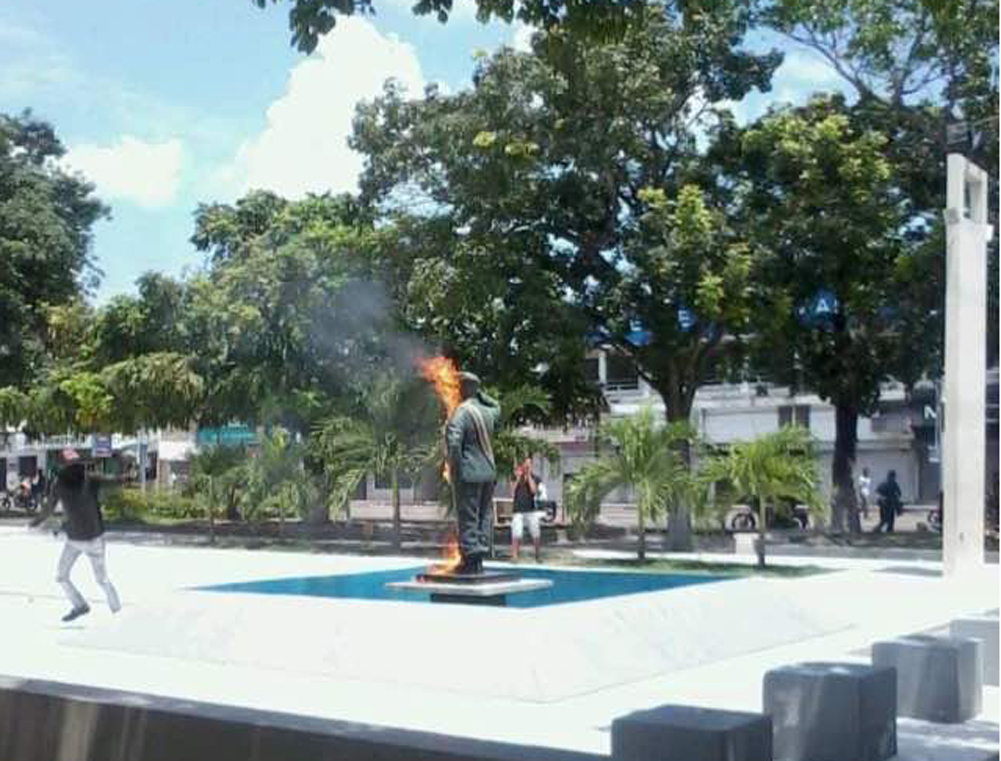Amid economic chaos, food shortages and widespread protest, some believe the government has ‘hit rock-bottom’ – yet key figures remain loyal to the president
by Virginia López
CARACAS – The demonstration began with a group of schoolboys, who gathered – still dressed in their school uniforms – in the palm-lined square outside the town hall of the prairie town of Villa del Rosario in western Venezuela.
Before long, some kind of flammable liquid was thrown at a life-sized statue of the late president Hugo Chávez and set alight. And then, to cheers from onlookers, the figurine itself – which appeared to be made of glass-fibre or plastic – was pulled down and dragged into the street.
In terms of historical significance, the incident is unlikely to rank alongside the toppling of Saddam Hussein’s 12-metre statue in Baghdad, shortly after the 2003 invasion of Iraq.
But the destruction of the statue last Friday did not go unnoticed in a country where many public buildings are still adorned with images of Chávez, four years after his death.
Over the weekend, cellphone pictures and footage of the incident went viral in Venezuela, where widespread discontent with President Nicolás Maduro, Chávez’s handpicked successor, has erupted into near-daily protests.
Since then, the gesture has been repeated elsewhere: in Ureña, a town in western Venezuela, a bust of Chávez disappeared from a public square, and in the late leader’s home state of Barinas, a mural with the leader’s face reproduced in the style of Warhol’s Marilyns was defaced.
Some argue that such incidents demonstrate that after years of economic chaos, food shortages and government repression, Venezuelans have finally reached the breaking point.
“This showed that the government is hitting rock-bottom,” said Marinelis Soto, an accountant who lives near Villa del Rosario. “This happened in a town that used to be pro-government – and now people are so angry that they are constantly blocking roads.”
But others warn that, as Maduro moves forward with plans to rewrite the country’s constitution despite six weeks of anti-government protests – talk of a tipping point still seems premature.
Hundreds of thousands have joined near-daily demonstrations, but many ordinary Venezuelans – and the country’s political and military elites – remain loyal to Chavismo, ideology following in the footsteps of Chávez. And according to Luís Vicente Leon, a leading pollster, the collapse of authoritarian regimes is more often caused by internal splits than outside pressure.
“Fractures [in the government] always exist, but we can’t talk about reaching critical mass,” he said.
“In these processes, what you see are internal fissures that are so deep that they lead to an implosion. They don’t come from the opposition, or from a crisis. They generally come from inside,” he said.
One sign of such internal divisions came in March when the country’s attorney general, Luisa Ortega, condemned an attempt by the government-stacked supreme court to strip the opposition-led congress of its power as “a rupture of the constitutional thread”.
The move was soon put on hold, but Ortega has since become more outspoken. In an interview with the Wall Street Journal, she condemned the government’s mismanagement of the economy and expressed support for the protesters.
“We cannot demand that the citizens behave peacefully and legally in front of a state that is taking decisions that do not obey the law,” Ortega said.
In recent weeks, Maduro has come under criticism from a number of unexpected sources. The 20-year-old son of the country’s ombudsman, Tarek William Saab, read a letter to his own father on YouTube, in which he pleaded with him to “put an end to the injustices afflicting his country”. Yibram Saab published his message after he had joined a protest in which a 20-year-old student was killed.
“It could have been me,” Saab told his father.
Last week, the death of a 17-year-old viola player prompted the conductor Gustavo Dudamel – who had been criticised for not speaking out – to issue a statement criticizing the government and demanding Maduro to put an end to violence.
Maduro’s decision to call for a constituent assembly has also earned him criticism from high-ranking figures on the left of his party, who see the move as an affront to Chávez’s legacy. (Chávez oversaw the drafting of a new constitution in 1999, which he declared was “perfect”.)
“The Constituent assembly is a risky step and a great historical responsibility. It opens a space through which elements that destroy our revolution could enter,” Rafael Ramírez, Venezuelan ambassador to the UN and one of Chávez’s key allies, wrote in a local newspaper over the weekend.
Although pressure on Maduro may be mounting, it is still not coming from two key areas, Leon said. “The electoral authorities validated the constituent assembly, and perhaps most important, we haven’t seen the military express dissent,” he said.
For now, the war of attrition between government and opposition looks set to continue, and the death toll seems certain to rise.
Monica Pérez, who lives close to the square where the Chávez monument once stood, said that the toppling of the statue had galvanized the opposition in the town.
“It was the first time I saw this happen here,” she said. “We all feel the moment is now, and we must continue in the streets until the end.” (Reported by the Guardian).



